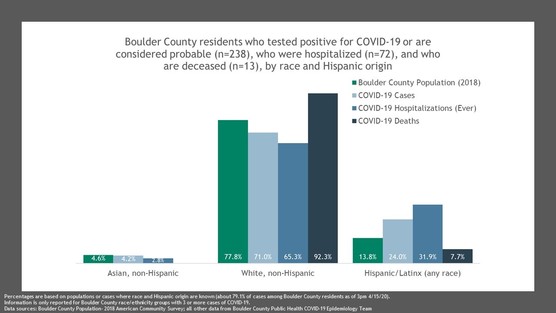April 16, 2020
COVID-19 Race/ethnicity Data Analysis Illustrates Disparities in Boulder County
Boulder County, CO — Boulder County Public Health epidemiology staff completed the first analysis on Boulder County COVID-19 data by race/ethnicity. About 79% of cases in Boulder County have a known race and ethnicity, which is slightly higher than Colorado as a whole, where roughly 75% of all state cases have been reported with a known race and ethnicity.
The data illustrates large disparities in the percentage of Boulder County residents who identify as Hispanic/Latinx (any race) who have tested positive or are considered probable for COVID-19. While Hispanic/Latinx individuals make up roughly 13.8% of the Boulder County population, they account for about 24% of the county’s COVID-19 cases and nearly one-third (31.9%) of those ever hospitalized during their COVID-19 illness. These disparities among Hispanic/Latinx folks in Boulder County are larger than the disparities seen statewide, where Hispanic/Latinx people represent about 21.7% of the population and 28.1% of COVID-19 cases.
“These disparities are concerning beyond the data points alone,” said Emily Payne, Boulder County Public Health epidemiologist. “We know that the Hispanic/Latinx population is younger in Colorado and Boulder County than the white non-Hispanic population. Despite this, there is a disproportionate percentage of Hispanic/Latinx residents in Boulder County with COVID-19 disease severe enough to warrant hospitalization.”
Because of unequal access to health care and economic opportunities, occurring over many generations, Hispanic/Latinx individuals in Colorado are also more likely to have some chronic diseases, including overweight or obesity and diabetes, which are known to increase the potential severity of COVID-19.
“At the heart of these disparities is systemic racism which we know from research produces institutional barriers to things like preventive medical care, healthy food, safe and stable housing, quality education, reliable transportation, and clean air. These barriers negatively impact a person’s health outcome,” said Jeff Zayach, Boulder County Public Health executive director. “COVID-19 does not discriminate, it affects people of every age and race/ethnicity. Using this data helps us to focus our prevention efforts to ensure all people in our community have equal access to information, opportunities, and care.”
Boulder County and many municipalities within the county are already working collaboratively to address disparities. Initiatives include connector and cultural broker programs that include trusted representatives from harder-to-reach communities who share information and relay concerns back to local government, non-profit agencies, and private businesses for action. Data like this reinforces the importance of continuing and building on this work to ensure services, practices, and structures provide all people the opportunity for a healthy life.
In addition, although the data shows a larger proportion of deaths among white non-Hispanic residents, 80% of deaths (12 of 15) to date have been among Boulder County residents living in long-term care facilities.
“Research has shown that access to long-term care facilities has been much lower among Asian, Black/African American, and Hispanic/Latinx older adults, which may also account for some of the results related to deaths,” said Payne. To help protect the identity of residents, data for race and ethnicity groups was only included when there were at least three cases of COVID-19 in a group.
For more information about COVID-19 illness and recovery among Boulder County residents, visit www.boco.org/covidillnessrecovery.
-BoulderCountyHealth.org-

Percentages are based on populations or cases where race and Hispanic origin are known (about 79.1% of cases among Boulder County residents as of 3pm 4/15/20). Information is only reported for Boulder County race/ethnicity groups with 3 or more cases of COVID-19. Data sources: Boulder County Population- 2018 American Community Survey; all other data from Boulder County Public Health COVID-19 Epidemiology Team

